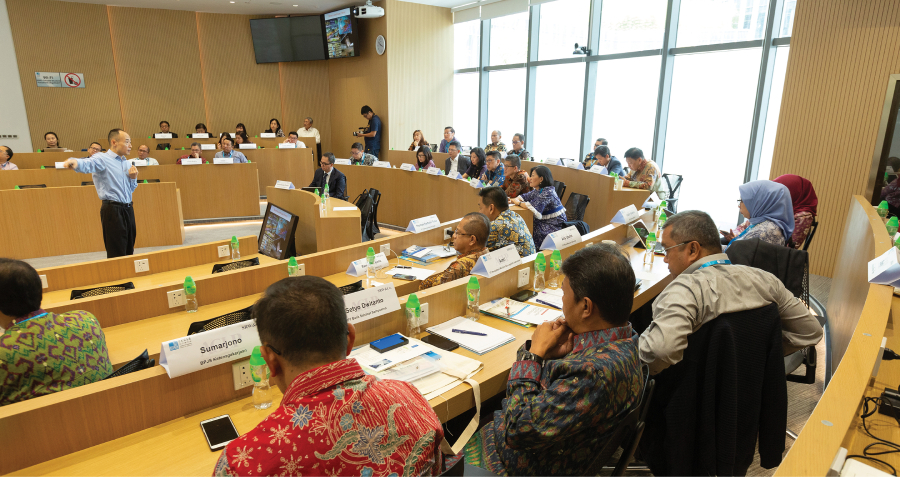“I was not a big saver in the past, but I am now trying to save as much of my salary as possible due to the global economic uncertainty,” says Lydia Chen, a 32-year-old administrator in Shanghai, who started stashing away ¥4,000 ($550) from her monthly paycheck in 2024. “If it continues, my earning power may be affected, so I am thinking about my long-term future and whether I want to be dependent on the state pension.”
China has long been a nation of savers, but the decision being made by Chen and many others to cut back on spending and not rely so much on pension schemes stems from a lack of confidence in the future. Trade ructions are a fresh motivator but the weak social security net has been an issue for many years.
“The financial burden posed by China’s underfunded social security and pension system is ringing alarm bells in Beijing as it risks not only economic growth prospects but long-term social cohesion,” said Zongyuan Zoe Liu, author of Sovereign Funds: How the Communist Party of China Finances its Global Ambitions and a senior fellow for China studies at the Council on Foreign Relations.
Past, present and pension
China’s pension system is staggering in its size and scale, but contributions and payouts are limited. The first and biggest of the system’s three main pillars is the state-managed basic pension, which is funded by central and local governments’ fiscal budgets and contributions from working people—with current earners in effect paying for current retiree pensions.
There were 1.07 billion enrollees at the end of March 2025, according to China’s Ministry of Human Resources and Social Security, comprising 536 million people in a mandatory scheme and 535 million people for the voluntary system. There are discrepancies in payouts between residents in Tier-1 cities such as Shanghai, and those in rural areas and non-formal employment, who are often in the voluntary scheme.
The most generous remuneration goes to state retirees such as former civil servants and schoolteachers, with retired urban salaried employees receiving an average of ¥3,742 ($517) per month in 2023, while the average voluntary pension system pay-out was just $30 (¥223) per month. Rent for a one-bedroom apartment in a Tier 2 city can reach ¥3000, meaning that although enrolment may be high, the payouts themselves are often negligible for the majority.
The second pillar is voluntary corporate pensions. The scheme is a payroll-based contributory plan to which employees contribute 8% of their wages and enterprises contribute 16%. But, by the end of 2024, just 159,287 businesses had established such a scheme, with 32.4 million people participating and ¥3.64 trillion ($0.5 trillion) invested.
The third and newest pillar is voluntary private pension schemes run by insurance companies, introduced in November 2022. Resembling the Roth IRA in the US, people can contribute up to ¥12,000 annually into a tax-sheltered account for buying eligible pension fund products such as wealth management products, deposits and insurance. Although 72.8 million private pension accounts had been opened by the end of November 2024, analysts estimated only one-quarter received contributions last year, bringing cumulative investment to just ¥45 billion ($6.22 billion).
In 2019, the Chinese Academy of Social Sciences warned that the National Social Security Fund, the country’s state pension fund, would probably be depleted by 2035. And a year later, the Insurance Association of China estimated that the shortfall in China’s pension gap would grow to ¥8-10 trillion during 2025-2030. China’s overall social security network, comprising pensions, unemployment, work-related injury, health and maternity leave, recorded its first annual deficit in 2020.
The system as a whole is struggling under the strain of a rapidly aging population and declining birthrate. “More elderly citizens are claiming retirement benefits while fewer working adults are contributing to the pension fund,” said Liu.
Exacerbating inequality
Although the expansion of China’s basic pension to three-quarters of the population has been lauded by the likes of the World Bank, the system is still far from perfect, with income inequality suppressing consumption and impacting economic growth, as well as loading an unsustainable burden on younger generations.
“The absence of a robust, well-developed pension system increases the need to save today to ensure safety tomorrow, especially when healthcare or hospital needs are typically higher post-retirement. This suppresses consumption in the current period,” said Liu.
“The pension also stratifies the elderly population, resulting in remarkable income inequality among them, and there is a significant benefit gap between employee and resident pensions,” says Xian Huang, author of Social Protection under Authoritarianism: Health Politics and Policy in China and an associate professor of political science at Rutgers University, noting that the basic pension for residents ranges only 10-25% of per capita consumption and 7-20% of per capita income, depending on location.
The income inequality reflected in the nature of the pension system has a chain effect on many aspects of the household economy, including consumption, investment and wealth accumulation. Households with secure pensions tend to invest more in their quality of life, while those with less secure pensions may prioritize saving over spending, impacting overall economic growth, according to Liu.
A need for reform
Increased savings rates are counterproductive to Beijing’s desire to boost consumer spending, suggesting a need for change.
“China’s pension system is in urgent need of reform due to demographic changes, financial unsustainability and growing social risks,” says Yan Zhe, a postdoctoral research fellow at Constructor University in Bremen and an expert in China’s welfare regime. “Without significant changes, the system could come under severe strain, exacerbating economic imbalances and intergenerational inequity.”
The most urgent issue pressuring China’s pension funds is their long-term sustainability as the working-age population’s share of the total continues to shrink. The number of people aged 15-59 on the Chinese mainland has declined every year since peaking at 940.72 million or 69.8% of the total in 2011, shrinking by more than 80 million people to 857.98 million or 60.9% in 2024. Fewer than three workers are now supporting a retiree in the current employment-based pension, according to Huang.
Youth unemployment puts additional strain on the pension system due to reduced contributions to social insurance funds. China’s youth unemployment rate, excluding college students, rose to 16.9% in February—down from a peak of 21.3% in June 2023, when the government temporarily suspended publication of the data while revising its calculation methodology. This has coincided with weaker job security in China amid the rise of the gig economy. There is no official data for the number of gig workers, but of China’s 200 million flexible workers, Chinese media has reported that one-tenth are daily-wage workers.
Efforts to improve equity and sustainability in the pension system are also stymied by cultural factors. For centuries Confucian filial piety has formed the backbone of China’s elderly care system, with the responsibility of caring for the elderly primarily resting on adult children—in particular sons. Though this has changed to some degree with expanding pension coverage, the state’s responsibility for old-age care within families is arguably not as effective as it should or could be.
It is also debatable whether China’s local governments have the wherewithal to shoulder greater financial burdens related to pensions. The Chinese pension system is highly decentralized, with most funding and management responsibilities falling to local governments. However, their ability to absorb rising pension costs is severely constrained as they are also grappling with reduced revenues and massive debt piles. And state-run pension funds also lack access to meaningful market investment opportunities.
“Aging industrial provinces like those in northeast China face severe shortfalls due to declining workforces, as young workers migrate to coastal cities, and more retirees than contributors. Many local governments cannot sustainably increase pension funding without central support or structural reforms,” said Yan.
As local governments reach their fiscal limits, China is exploring alternative solutions such as national pooling of pension funds, which was partially implemented in 2022. While this reduces regional disparities, it faces political opposition from richer regions.
Pave the way for viability
Cognizant that it cannot put off pension reform any longer, Beijing has implemented a series of changes over the last decade in response to the challenges. Huang says the most important change has been to gradually centralize the enterprise employee pension fund, the largest in China’s public pension system.
In early 2022, the central government introduced a national balancing mechanism for the mandatory basic pension fund that essentially allowed deficits in certain provinces to be compensated by nationwide surpluses—representing a serious step toward centralizing pension funds. “Centralization aims to address the pension insolvency in the rust belt regions by taking advantage of the pension surplus in younger and economically developed regions,” said Huang.
The long-awaited hiking of retirement ages for younger generations, and the corresponding increase of contribution periods for pension benefits, represented a milestone. For the first time in more than 40 years, at the start of January, authorities upped the statutory retirement age for men from 60 to 63, and for women, from 50 to 55 for blue-collar workers and from 55 to 58 for white-collar occupations.
But the hike may be a case of kicking the deficit can down the road. “Raising the retirement age can raise the risk of a default in pension payments because delaying retirement simply pushes more individuals into claiming benefits later, potentially overdrawing the system’s resources,” said Liu.
The government has several more policy levers it could pull to strengthen sustainability while mitigating social risks. Full national pooling of funds springs to mind, along with the introduction of progressive contribution rates based on income so that higher earners pay more. At the same time, gig workers and the informally employed could enjoy more flexible contribution levels.
In a nod to China’s cultural factors, Yan suggests implementing fertility incentives with pension linkages, such as additional pension credits for parents or grandparent care credits that count toward pension eligibility. “These options take into account the unique Chinese context of intergenerational care and harmony. The idea is to spread the burden, financial and otherwise, across generations while maintaining social stability.”
Grow the pension pot
Beijing appears to be dithering on deeper pension reforms despite the serious structural challenges facing the existing system. “China’s reforms don’t go far enough to prevent a future crisis in my opinion,” said Yan. “Demographics are moving faster than reforms. Without bolder increases in the retirement age or higher birth rates, the system remains mathematically unsustainable.”
There are no quick fixes for such a daunting predicament that also looms over other major economies. But perhaps the simplest way Beijing could shore up the long-term sustainability of China’s pension funds is to get economic growth back on track.
“This all goes back to how robustly the Chinese economy can grow,” said Liu. “It all ripples out—if the labor market doesn’t improve, then pension revenue will struggle to grow and the government will be under even more pressure to fill the gap.”




















